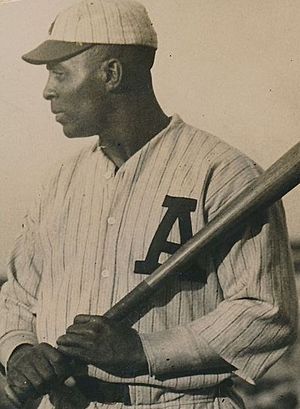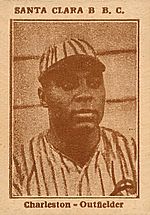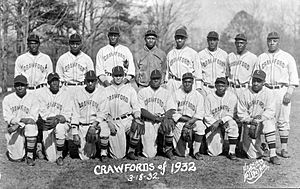Oscar Charleston facts for kids
Quick facts for kids Oscar Charleston |
|||
|---|---|---|---|
 |
|||
| Center fielder | |||
| Born: October 14, 1896 Indianapolis, Indiana |
|||
| Died: October 5, 1954 (aged 57) Philadelphia, Pennsylvania |
|||
|
|||
| debut | |||
| 1915, Indianapolis ABCs | |||
| Last appearance | |||
| 1941, Philadelphia Stars | |||
| NBL statistics | |||
| Batting average | .364 | ||
| Hits | 1,207 | ||
| Home runs | 143 | ||
| Runs batted in | 853 | ||
| Stolen bases | 209 | ||
| Managerial record | 420–377 | ||
| Teams | |||
As player
As manager
|
|||
| Career highlights and awards | |||
|
|||
| Induction | 1976 | ||
| Election Method | Negro League Committee | ||
Oscar McKinley Charleston (born October 14, 1896 – died October 5, 1954) was an amazing American center fielder and manager in Negro league baseball. He played or managed for over a dozen teams during his 43-year baseball career. Some of his most famous teams were the Homestead Grays and the Pittsburgh Crawfords. These were top teams in the Negro leagues during the 1930s.
Oscar Charleston also played nine seasons in Cuba during the winter. He played in many exhibition games against white Major League Baseball players. In 1976, he was honored by being inducted into the National Baseball Hall of Fame.
Charleston was one of the first big stars of the Negro leagues. By 1920, many people thought he was the best center fielder and one of the strongest hitters in black baseball. He shares the record for most Negro league batting titles (three) with Josh Gibson. He is also the only player to win batting titles in different leagues. He won the Triple Crown (leading in batting average, home runs, and runs batted in) three times. This is the most for any player in Major League Baseball history. He has the second-highest career batting average ever, right after Ty Cobb.
In 1915, after serving in the U.S. Army, Charleston started his professional baseball career. He joined the Indianapolis ABCs in his hometown of Indianapolis, Indiana. He played in the very first game of the Negro National League on May 20, 1920. His best season was in 1921 with the Saint Louis Giants. That year, he hit 15 home runs and had a .437 batting average. In 1933, Charleston played in the first Negro National League All-Star Game. He also played in the 1934 and 1935 All-Star games. Later, in 1945, Charleston became the manager of the Brooklyn Brown Dodgers. He helped find talented black players like Roy Campanella for the first integrated Major League Baseball teams. His long career ended in 1954 as a player-manager for the Indianapolis Clowns.
Contents
Early Life and Baseball Beginnings
Oscar McKinley Charleston was born in Indianapolis, Indiana, on October 14, 1896. He was one of eleven children. His younger brother, Bennie Charleston, also played baseball with him on the 1932 Pittsburgh Crawfords. Oscar's father, Tom Charleston, worked in construction and used to be a jockey. Oscar loved playing baseball in empty lots as a kid. He even worked as a batboy for the Indianapolis ABCs.
When he was fifteen, on March 7, 1912, Oscar joined the U.S. Army. He served in the Philippines. While there, he ran track and played baseball for his army team. In 1914, at age seventeen, he pitched for his regiment in the Manila League. He even pitched a shutout game. After his time in the army, Charleston decided not to stay. He returned to Indianapolis in April 1915.
On November 24, 1922, Charleston married Jane Blalock Howard. She was from Harrisburg, Pennsylvania. They often traveled together when he played and managed for the Harrisburg Giants. Oscar and Jane did not have any children.
A Star Player and Manager
From 1915 to 1954, Oscar Charleston was a player or manager for many teams. These included the Indianapolis ABCs, Chicago American Giants, Homestead Grays, and Pittsburgh Crawfords. He was a player-manager until 1941. His baseball career continued as a manager until he passed away in 1954. Besides playing in the Negro leagues, Charleston also played in many exhibition games. These were against all-white teams before major league baseball allowed black players in 1947. He also played nine winter seasons in Cuba.
Official statistics for Negro league players are not always complete. Different sources might show slightly different numbers. For example, the National Baseball Hall of Fame and Museum website says Charleston's career batting average was .339. Other sources say it was .357. What everyone agrees on is that he was an amazing player!
Early Years: 1915–1920
After leaving the U.S. Army in 1915, Charleston started his baseball career with the Indianapolis ABCs. He earned $50 a month. On April 11, 1915, he pitched his first game for the ABCs. It was a 7–0 shutout against a semi-professional team. Charleston, called "Charlie" by his teammates, soon became a center fielder. He was known for playing close to second base and catching balls with one hand. He was very good at catching high fly balls because he was so fast. His strong hitting and fielding skills earned him the nickname "Hoosier Comet."
In 1916, Charleston helped the Indianapolis ABCs win "The Championship of Colored Baseball." This was a big deal before the first Negro World Series in 1924. Charleston left the ABCs in 1918 to join a training program during World War I. He served for less than two months before the war ended. When he returned to Indiana in 1919, his old team didn't have a season. So, he joined the Chicago American Giants.
Negro League Player: 1920–1941
When the Negro National League started in 1920, Charleston went back to Indianapolis. He played center field for the ABCs in the league's first game on May 20, 1920. The ABCs won both games of a doubleheader that day. Charleston stayed with the ABCs until 1921. Then, he signed with the Saint Louis Giants, who paid him $400 a month. This was the highest salary in the league! His best season was with the Saint Louis Giants in 1921. He hit fifteen home runs, twelve triples, and seventeen doubles. He also stole thirty-one bases in sixty games. His batting average that year was .434. He led the league in doubles, triples, and home runs.
When the Giants team closed down in 1921, Charleston returned to the ABCs. He stayed until 1924. Then, he became a player-manager for the Harrisburg Giants in Pennsylvania. Charleston played for the Harrisburg team until 1927. After that team ended, he played for the Hillsdale Club for two seasons (1928 and 1929). He then spent two seasons (1930 and 1931) with the Homestead Grays. As Charleston got older, he moved from center field to first base. He also played nine seasons of winter baseball in Cuba, with a .361 batting average.
In 1932, Charleston became the player-manager of the Pittsburgh Crawfords. This team had many future Hall of Famers like Josh Gibson, Satchel Paige, and Judy Johnson. Cool Papa Bell joined the Crawfords in 1933. The Negro National League started again in 1933. The Pittsburgh Crawfords and Homestead Grays became the top teams in the 1930s. They often played for championships and had many future Hall of Famers.
Between 1932 and 1936, the Crawfords were thought to be the best team in professional baseball. In 1932, Charleston batted .363. He received the most votes from fans (43,000) to play first base in the first East-West All-Star Game on September 10, 1933. This game was held at Chicago's Comiskey Park in front of 20,000 fans. Charleston also played first base in the 1934 and 1935 Negro League All-Star Games. The Crawfords won the 1935 Negro National Team pennant. Many people consider the 1935 Crawfords team the best in Negro League history.
Charleston's playing career was ending when the Pittsburgh Crawfords team changed owners in 1939. Charleston moved with the team to Toledo, Ohio. But the team didn't get enough fans there, so it moved to Indianapolis in 1940. The Indianapolis Crawfords also struggled to find fans. Charleston retired as a professional player in 1941. From 1942 to 1944, he played for a semi-pro team in Philadelphia. In 1945, at age 49, Charleston briefly played again as a pinch hitter and first baseman while managing the Brooklyn Brown Dodgers.
Team Manager and Scout: 1941–1954
In the winter of 1940–41, Charleston became the manager of the Philadelphia Stars. He returned to the Stars as a first base coach in 1944. In 1945, Branch Rickey hired Charleston to manage the Brooklyn Brown Dodgers. This team was created to find talented black players for Major League Baseball. Once they found players, the team closed. Charleston helped find players like Roy Campanella.
In 1946, Charleston returned to manage the Philadelphia Stars for five more seasons. He retired from managing them at the end of 1950.
When Major League Baseball teams started allowing black players in the late 1940s, the Negro leagues began to decline. In 1954, Charleston briefly came out of retirement to manage the Indianapolis Clowns. This team traveled a lot. The Clowns won the Negro American League pennant in 1954. Charleston returned to Philadelphia shortly before he passed away that fall.
Umpiring
Besides being a manager and scout, Charleston also worked as an umpire for the Negro National League starting in 1946. In 1947, he umpired an NNL-NAL all-star game.
Death and Legacy
In early October 1954, Oscar Charleston became sick. He passed away on October 5, 1954, at age 57, in a Philadelphia, Pennsylvania, hospital. He is buried in Floral Park Cemetery in Indianapolis, Indiana.
Oscar Charleston was a very famous player. He was known for his strong hitting, his speed as a base runner, and his excellent fielding. People often compared him to other great players like Ty Cobb, Tris Speaker, and Babe Ruth. Charleston is among the top five Negro league players for home runs and batting average. He also led the league in stolen bases.
In 1998, The Sporting News listed the 100 greatest baseball players. Charleston was ranked sixty-seventh. Only four other black players from the Negro leagues were ranked higher: Josh Gibson, Satchel Paige, Buck Leonard, and Cool Papa Bell. In 1999, Charleston was also nominated for Major League Baseball's All-20th Century Team.
Charleston's reputation has grown a lot in recent years. Baseball writer Bill James said that Charleston "did everything exceptionally well." He ranked Charleston as the fourth-best player of all time, after Ruth, Honus Wagner, and Willie Mays. Many baseball experts now think Charleston was not just the greatest all-around Negro league player, but possibly the greatest baseball player ever.
His teammates and rivals also praised him. “Oscar Charleston was Willie Mays before there was a Willie Mays,” said “Double Duty” Radcliffe. “Except that he was a better base runner, a better center fielder and a better hitter.”
Hall of Fame manager John McGraw once said, “If Oscar Charleston isn’t the greatest baseball player in the world, then I’m no judge of baseball talent.” Famous sportswriter Grantland Rice wrote a column about Charleston called “No Greater Ball Player.” He said, “It’s impossible for anybody to be a better ballplayer than Oscar Charleston.”
Honors and Awards
- Charleston was inducted into the Baseball Hall of Fame in 1976.
- He was inducted into the Indiana Baseball Hall of Fame in 1981.
- The Indianapolis chapter of the Society for American Baseball Research is named the Oscar Charleston Chapter.
- Oscar Charleston Park on East 30th Street in Indianapolis is named in his honor.
Images for kids
See also
 In Spanish: Oscar Charleston para niños
In Spanish: Oscar Charleston para niños






